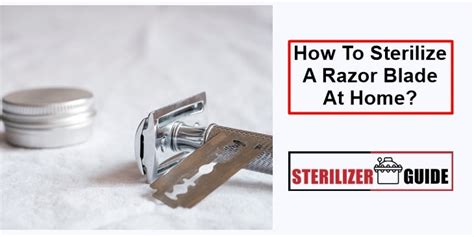How to Sterilize a Blade: Quick and Effective Steps
Keeping blades sterile is crucial for various tasks, from surgical procedures to crafting and even food preparation. Whether you're dealing with a scalpel, a razor blade, or a craft knife, proper sterilization is paramount to prevent infection or contamination. This guide outlines quick and effective methods for sterilizing blades, focusing on both practical application and safety.
What Does "Sterilize" Really Mean?
Before diving into methods, let's clarify what sterilization entails. Sterilization means completely eliminating all forms of microbial life, including bacteria, viruses, fungi, and spores, from a surface. This is different from disinfection, which reduces the number of microbes but doesn't guarantee complete elimination. When sterilizing a blade, complete elimination is the goal.
Methods for Sterilizing Blades
The best method for sterilizing a blade depends on the type of blade, the materials it's made from, and the level of sterility required.
1. Autoclaving (High-Heat Steam Sterilization):
This is the gold standard for sterilization, particularly in medical settings. Autoclaves use high-pressure steam at high temperatures (typically 121-134°C or 249-273°F) to kill all microbes. Autoclaving is only suitable for metal blades that can withstand extreme heat and pressure. This is not a home method; it requires specialized equipment.
2. Dry Heat Sterilization:
This method involves exposing the blade to high temperatures (typically 160-170°C or 320-338°F) in a dry heat oven for a specific duration. Similar to autoclaving, this method is suitable only for metal blades and requires specialized equipment. It's less effective than autoclaving and takes longer.
3. Chemical Sterilization:
Several chemicals can sterilize blades, but they must be handled with extreme care due to their potential toxicity. These include:
- Glutaraldehyde: A powerful sterilant, but it's toxic and requires careful handling and disposal. This method should only be used by trained professionals.
- Ethylene Oxide: Another effective sterilant, but it's also highly toxic and requires specialized equipment and training for safe use. Again, this is not a method for home use.
- Isopropyl Alcohol (70%): While not a true sterilant, 70% isopropyl alcohol effectively disinfects blades, killing many bacteria and viruses. It's widely accessible but won't kill all spores. This is a useful method for quick disinfection, but not sterilization.
4. Boiling:
Boiling blades in water for at least 10 minutes can kill many, but not all, microorganisms. This is a simple method, but its effectiveness is limited, and it's not suitable for all blade types (e.g., those with wooden or plastic handles). Boiling is best considered as a disinfection method rather than true sterilization.
5. UV Sterilization:
Ultraviolet (UV) light can kill many microbes but is not always reliable for complete sterilization. The effectiveness depends on the intensity of the UV light, the exposure time, and the type of microbe. UV sterilization boxes are available for certain applications, but they might not be sufficient for complete sterilization of all types of blades.
Choosing the Right Method:
The choice of sterilization method depends entirely on the context:
- Medical Settings: Autoclaving is the preferred method.
- Home Use (Craft Knives, Razor Blades): 70% isopropyl alcohol disinfection is generally sufficient for most home applications, followed by thorough rinsing and drying. Boiling for disinfection might be an option for some.
- Precision Work (Microsurgery): Autoclaving or other advanced sterilization methods are essential.
Safety Precautions:
Always handle blades with caution. When using chemicals, wear appropriate personal protective equipment (PPE), including gloves, eye protection, and a mask. Properly dispose of used chemicals according to local regulations. Never attempt to sterilize a blade if you are unsure of the process or the safety implications.
What are the different ways to sterilize surgical blades?
Surgical blades require the highest level of sterility, achieved primarily through autoclaving. Dry heat sterilization might also be used, but autoclaving is the gold standard in surgical settings due to its effectiveness and reliability.
How do you sterilize a razor blade at home?
For razor blades at home, a thorough cleaning followed by disinfection with 70% isopropyl alcohol is usually sufficient. Allow the blade to air dry completely before use. Boiling might be considered a less effective alternative, but remember this will only partially disinfect it, not fully sterilize it.
Can you sterilize a blade with rubbing alcohol?
Rubbing alcohol (isopropyl alcohol) is a disinfectant, not a sterilant. It effectively kills many bacteria and viruses but won't necessarily eliminate all microorganisms, including spores. Therefore, it's a suitable option for disinfecting blades in non-critical settings, but not for achieving true sterilization.
Conclusion:
Sterilizing blades effectively requires selecting the appropriate method based on the specific needs and available resources. Always prioritize safety, and if unsure, consult a professional. Understanding the difference between sterilization and disinfection is critical for preventing contamination and ensuring safety. Remember, this information is for general guidance only and should not be considered a substitute for professional advice.

